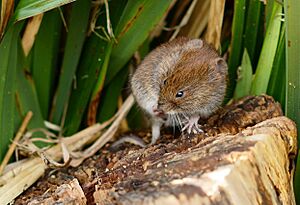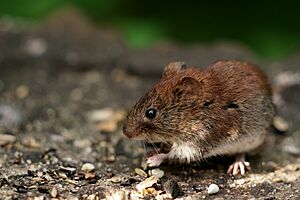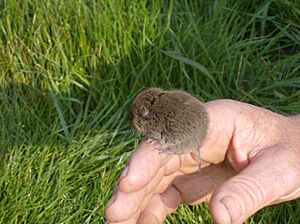Vole facts for kids
Quick facts for kids Vole |
|
|---|---|
 |
|
| The bank vole (Myodes glareolus) lives in woodland areas in Europe and Asia. | |
| Scientific classification | |
| Kingdom: | Animalia |
| Phylum: | Chordata |
| Class: | Mammalia |
| Order: | Rodentia |
| Family: | Cricetidae |
| Subfamily: | Arvicolinae |
| Groups included | |
|
|
| Cladistically included but traditionally excluded taxa | |
|
|
Voles are small rodents, which means they are part of a group of mammals that have front teeth designed for gnawing. They are related to lemmings and hamsters. You might sometimes hear them called meadow mice or field mice because they look a bit like mice.
However, voles have some key differences from mice. They have a sturdier body, a longer and hairier tail, a slightly rounder head, and smaller eyes and and ears. Their teeth are also shaped differently, which helps them eat their favorite foods. There are about 155 different kinds of voles!
Contents
What are Voles?
Voles are tiny creatures, usually growing to be about 3 to 9 inches (8 to 23 cm) long, depending on their specific type. They are known for being very busy and active.
They look a bit like other small animals such as moles, gophers, mice, rats, and even shrews. All these animals share some similar features and behaviors, especially when it comes to living underground.
Vole Life Cycle and Reproduction
Voles can have many babies very quickly! A female vole can have five to ten litters of young each year. After about three weeks of gestation (when the babies grow inside the mother), the young voles are born. They grow up fast, reaching sexual maturity in just one month.
Because they reproduce so quickly, vole populations can grow very large in a short amount of time. One pair of voles can produce around 100 offspring every year!
Most smaller voles live for about three to six months. It's rare for them to live longer than a year. Larger types, like the European water vole, can live a bit longer, sometimes through two or even three winters. Sadly, many voles (up to 88%) don't survive past their first month of life.
Where Voles Live and What They Eat
Voles love to eat small plants. They also enjoy juicy root systems and plant bulbs. They are excellent at burrowing and tunneling underground to find their food. This means they can sometimes damage garden plants and young trees by eating their roots or by girdling (eating the bark around the base of) small trees.
However, voles also play an important role in nature. Like other burrowing animals, their tunnels help to mix nutrients throughout the soil, which is good for the environment.
Who Hunts Voles?
Many animals consider voles a tasty meal! Their predators include martens, owls, hawks, falcons, coyotes, bobcats, foxes, raccoons, squirrels, snakes, weasels, domestic cats, and lynxes.
Owl pellets, which are undigested parts of an owl's meal that they spit up, often contain vole bones. This shows how important voles are as a food source for owls like the short-eared owl and the barn owl. Interestingly, in the summer of 2024, scientists at UC Davis even saw California ground squirrels hunting voles!
Vole Social Life and Family
Voles have different ways of forming families. Some voles might stay with one partner for a long time, while others might have many partners. The environment they live in, like how much food is available, can affect how they choose their mates.
Voles often live in groups or colonies because their young stay with the family for a while. Male voles can be territorial, meaning they protect their space. They might try to include the territories of several female voles in their area. Males often mark their territories and defend them.
Voles often prefer to mate with partners they are familiar with. They also have ways to avoid mating with very close relatives. This helps to keep their offspring healthy and strong. For example, the grey-sided vole often has males move away from their birth area to find mates.
Sometimes, female voles might share dens during the winter. This could be a way for them to stay warm and save energy when it's cold.
Voles and Empathy
Did you know that voles can show empathy? A study in 2016 looked at a specific type of vole called Microtus ochrogaster. Researchers found that these voles would comfort each other when one of them was upset or "mistreated." They would spend more time grooming the distressed vole.
The voles that were doing the comforting even showed similar stress hormone levels to the upset voles. This suggests they could feel what the other vole was feeling! When scientists blocked a hormone called oxytocin (which is linked to empathy in many animals), this comforting behavior stopped. This discovery was exciting because empathy was once thought to only happen in animals with very advanced brains, like humans, apes, and elephants.
The Vole Clock: Dating History
The vole clock is a special method used by archaeologists. It helps them figure out the age of different layers of earth at an archaeological site. They do this by studying the teeth of voles found in those layers. Since different vole species lived at different times, their teeth can act like a natural clock!
Vole Family Tree: Classification
Voles belong to the Order Rodentia, which includes all rodents. They are part of the Family Cricetidae, which also includes hamsters and lemmings. More specifically, they are in the Subfamily Arvicolinae.
Here are a few examples of the many different kinds of voles:
- Water voles (Genus Arvicola)
- Snow voles (Genus Chionomys)
- Mole voles (Genus Ellobius)
- Tree voles (Genus Arborimus)
- Heather voles (Genus Phenacomys)
- Red-backed voles (Genus Craseomys and Clethrionomys)
Images for kids








